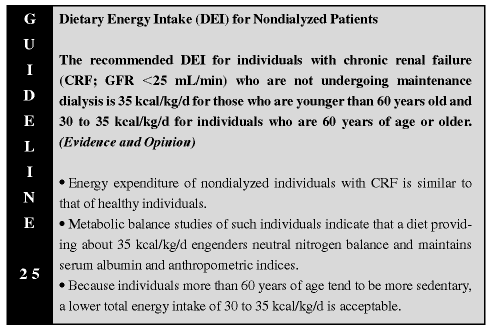

In patients with CRF who are not receiving dialysis therapy, energy expenditure (and hence energy requirements) when measured at rest, while sitting quietly, during prescribed exercise, or after ingesting a meal of a defined composition is similar to that of healthy subjects.154,155 Available evidence indicates that a diet providing about 35 kcal/kg/d is necessary to maintain neutral nitrogen balance, to promote higher serum albumin concentrations and more normal anthropometric parameters, and to reduce the UNA (ie, to improve protein utilization).211 These energy needs are similar to those described in the USRDA for normal adults of similar age.158 In CRF patients 60 years of age or older, who tend to be less physically active, an energy intake of 30 to 35 kcal/kg/d may be sufficient, although energy requirements of CRF patients in this age range have not been well studied. This latter recommendation is based, in part, on the recommended dietary allowances of older normal adults (US Recommended Dietary Allowances).158
The recommendation for this energy intake for individuals with GFR less than 25 mL/min is based on findings of low energy intakes in clinically stable individuals with this level of renal insufficiency and evidence that these patients often show signs of nutritional deterioration.196 Methods for measuring or estimating GFR are discussed in Appendix IX.
It may be difficult (or impossible in some circumstances) for patients to achieve this energy goal with dietary counseling alone. However, inadequate energy intake is considered to be one of the principal reversible factors contributing to malnutrition in the ESRD population. To facilitate compliance with the energy prescription, creative menu planning is encouraged, taking into consideration the patient's food preferences. Foods, beverages, and nutritional supplements with high energy density may be used. If sufficient energy intake to maintain nutritional status cannot be attained by these techniques, supplemental tube feeding may be considered.